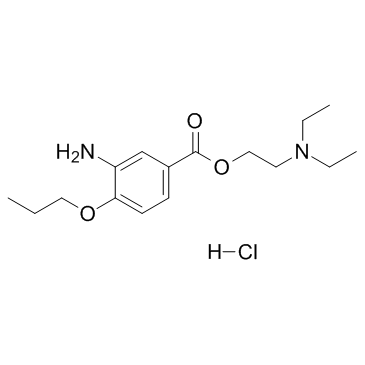5875-06-9
| Name | Proxymetacaine Hydrochloride |
|---|---|
| Synonyms |
EINECS 227-541-7
3-amino-4-propoxybenzoate de 2-(diéthylamino)éthyle chlorhydrate 2-(Diethylamino)ethyl-3-amino-4-propoxybenzolcarboxylathydrochlorid Proxymetacaine Hydrochloride Proxymetacaine Hcl 2-(Diethylamino)ethyl 3-amino-4-propoxybenzoate hydrochloride (1:1) Benzoic acid, 3-amino-4-propoxy-, 2-(diethylamino)ethyl ester, hydrochloride (1:1) 2-(diethylamino)ethyl 3-amino-4-propoxybenzoate,hydrochloride PROPARACAINE HCL Proparacaine hydrochloride MFCD00083467 2-(diethylamino)ethyl 3-amino-4-propoxybenzoate hydrochloride ak-taine |
| Description | Proparacaine Hydrochloride is a voltage-gated sodium channels antagonist with ED50 of 3.4 mM.IC50 Value: 3.4 mM(ED50) [1]Target: Sodium Channelin vitro: Proparacaine is more potent and less toxic than cocaine [1]. Proparacaine significantly increases in FHV-1 (P < 0.01), C. felis, and 28S rDNA Ct values when fusidic acid is used [2].in vivo: Proparacaine inhibits corneal epithelial migration and adhesion through alteration of the actin cytoskeleton [3]. Proparacaine acts like bupivacaine or lidocaine and produces dose-related spinal blockades of motor function, proprioception and nociception. Intrathecal proxymetacaine also produces longer sensory blockade than motor blockade [4]. |
|---|---|
| Related Catalog | |
| References |
| Boiling Point | 434.4ºC at 760mmHg |
|---|---|
| Molecular Formula | C16H27ClN2O3 |
| Molecular Weight | 330.850 |
| Flash Point | 216.5ºC |
| Exact Mass | 330.171021 |
| PSA | 64.79000 |
| LogP | 3.93940 |
| Storage condition | -20°C |
CHEMICAL IDENTIFICATION
HEALTH HAZARD DATAACUTE TOXICITY DATA
|
| Symbol |

GHS07 |
|---|---|
| Signal Word | Warning |
| Hazard Statements | H302-H312-H317-H319-H332 |
| Precautionary Statements | P280-P305 + P351 + P338 |
| Personal Protective Equipment | dust mask type N95 (US);Eyeshields;Faceshields;Gloves |
| Hazard Codes | Xn:Harmful |
| Risk Phrases | R20/21/22;R36;R43 |
| Safety Phrases | S26-S36 |
| RIDADR | NONH for all modes of transport |
| WGK Germany | 3 |
| RTECS | DG3065000 |
